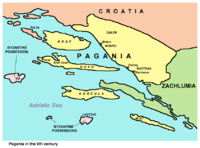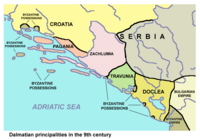Pagania
Pagania ( Latin Pagania , Slavic Pogania ) also Narentanien (Latin Narentia ) denotes the medieval South Slavic principality of the Narentans on the east coast of the Adriatic Sea . Presumably in the 11th century , the continental part fell to the neighboring Slavic principality of Zachumlien , while the islands came under the rule of Venice .
geography
According to Constantine, the lower reaches of the Cetina River formed the north- western limit and the mouth of the Neretva River formed the south-western limit of Pagania.
The area is said to have consisted of the three counties Rastoka, Mokros and Dalen on the mainland and the islands of Brač , Šolta , Hvar , Korčula , Vis and Lastovo . Cities in the region were Mokro , Ostrog , Slavineca as well as Hvar and Stari Grad .
population
The name Pagania used by Konstantin Porphyrogennetos in his work De Administrando Imperio indicates that the Narentans (probably Roman name: Arentani ) were still pagans in Constantine's time ( paganus = villagers; since the 4th century in Christian usage the name for a non-Christian ) were.
According to Constantine, the Narentans were Serbs who did not accept Christian baptism . Medieval writers often equated “Serbs” with the Slavs as a whole, as a Slavic original tribe or umbrella term for all Slavs. It is likely that Pagania was colonized by Croats from the 7th century .
Web links
literature
- Konstantin Porphyrogennetos, ca.950, De Administrando Imperio
- JB Bury: The early history of the Slavonic settlements in Dalmatia, Croatia, & Serbia. Constantine Porphyrogennetos. De administrando imperio.
Individual evidence
- ^ Heinrich Kunstmann : The Slavs, their name, their migration to Europe and the beginnings of Russian history in a historical and onomastic view . Steiner, Stuttgart 1996, ISBN 3-515-06816-3 , pp. 125 .



